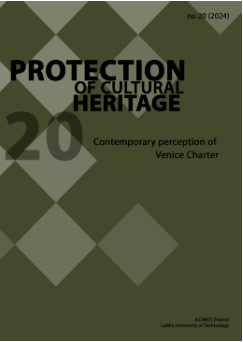Karta Wenecka a rozwój autentyczności
Abstrakt
Autentyczność była przedmiotem troski przez wiele stuleci. W XIX wieku, podczas interwencji restauratorskich w Notre Dame, było oczywiste, że autentyczność była związana wyłącznie z oryginalnym materiałem zabytku. Dopiero w Karcie Weneckiej z 1964 r. podjęto próbę zdefiniowania autentyczności. Od tego czasu zmieniło się postrzeganie i rozumienie tego, co jest autentyczne. Ta zmiana znaczenia jest częściowo spowodowana zmianami w usankcjonowanych definicjach dokumentów statutowych, które wpłynęły na wartości przypisywane przez społeczeństwo ich dziedzictwu. Chociaż Karta Wenecka wspominała o autentyczności, nie określała atrybutów, które dziedzictwo powinno zachować, aby można je było uznać za autentyczne. Miało się to zmienić, gdy dziedzictwo niematerialne i materialne zostały uznane za kryteria wpisania na Listę Światowego Dziedzictwa (szczególnie dzięki wkładowi japońskiego doświadczenia w zakresie dziedzictwa niematerialnego, gdy Japonia przystąpiła do Konwencji Światowego Dziedzictwa). Gdy dziedzictwo niematerialne i materialne zostało uznane za kryteria wpisu na Listę Światowego Dziedzictwa, autentyczność zaczęła być postrzegana nie tylko przez pryzmat materialności. Rozumienie autentyczności zostało rozwinięte poprzez dyskusje dotyczące miejsc światowego dziedzictwa, takich jak Abu Simbel, Historyczne Centrum Warszawy i Most Mostarski, które zostały wpisane na Listę Światowego Dziedzictwa po przeprowadzeniu w nich poważnych interwencji lub prac rekonstrukcyjnych. Artykuł kończy się dyskusją na temat tego, w jaki sposób charakterystyka użytego materiału, w szczególności w przypadku rekonstrukcji, może wpłynąć na autentyczne lub prawdziwe doświadczenie historycznego miejsca.
Słowa kluczowe:
autentyczność, materiał, wyjątkowa uniwersalna wartość, miejsca światowego dziedzictwaBibliografia
Carbonara, Giovanni& Pergoli Campanelli, Alessandro. “Dell Restauro del Tempio-Duomo di Pozzuoli” Restauro 35-36. 2010. https://documen.site/download/tempio-cattedrale-a-pozzuoli-10-alessandro-pergoli-campanelli_pdf.
Google Scholar
Denslagen, W. (1994) Architectural Restoration in Western Europe: controversy and continuity Amsterdam: Architectura & Nature Press.
Google Scholar
Denslagen, W. (2009). Romantic Modernism nostalgia in the world of Conservation. Amsterdam: Amsterdam University Press.
Google Scholar
Dezzi Bardeschi, Marco. N/A Tempio Duomo Rione Terra. http://www.marcodezzibardeschi.com/_Progetti/incorso/Tempio_Duomo.html
Google Scholar
Earl, J. (2003). Building Conservation Philosophy. Shaftesbury: Donhead.
Google Scholar
ICOMOS (1964). International Charter for the Conservation and Restoration of Monuments and Sites. (The Venice Charter 1964) https://www.icomos.org/en/participer/179-articles-en-francais/ressources/charters-and-standards/157-thevenice-charter.
Google Scholar
ICOMOS (1994) The Nara Document on Authenticity. https://www.icomos.org/en/charters-and-texts/179-articles-en-francais/ressources/charters-and-standards/386-the-nara-document-on-authenticity-1994.
Google Scholar
ICOMOS, (1931) The Athens Charter for the Restoration of Historic Monuments – 1931. https://www.icomos.org/en/167-the-athens-charter-for-the-restoration-of-historic-monuments.
Google Scholar
ICOMOS, (n/d) Berg, L. The Salvage of the Abu Simbel Temples. https://www.icomos.org/public/monumentum/vol17/vol17_2.pdf.
Google Scholar
Jokilehto, J. (1999). A History of Architectural Conservation. Oxford, England: Butterworth-Heinemann.
Google Scholar
Kiniry L. (2018) Egypt’s exquisite temples that had to be moved. https://www.bbc.com/travel/article/20180409-egypts-exquisite-temples-that-had-to-be-moved.
Google Scholar
Madrid Conference (1904) Sixth International Congress of Architects, https://docslib.org/doc/4463614/recommendations-of-the-madrid-conference-1904-sixth-international-congress-of-architects.
Google Scholar
Mehr, S. (2019) Analysis of 19th and 20th Century Conservation Key Theories in Relation to Contemporary Adaptive Reuse of Heritage Buildings. Heritage. DOI:10.3390/heritage2010061.
Google Scholar
Munoz Vinas, S. (2023) A theory of Cultural Heritage. Beyond the intangible. Oxforshire, UK, Routledge.
Google Scholar
Ruskin, J. 1989, The Seven Lamps of Architeture. Dover Publications.
Google Scholar
Stovel, H (2008) Origins and influence of the Nara document on Authenticity. APT Bulletin 39 (2/3): 9-17. https://www.iccrom.org/sites/default/files/publications/2020-05/convern8_01_hstovel_ing.pdf.
Google Scholar
UNESCO. (n/d). Historic Centre of Warsaw. https://whc.unesco.org/en/list/30/.
Google Scholar
UNESCO. (1980). Operational Guidelines for the implementation of the World Heritage Convention. https://whc.unesco.org/archive/opguide80.pdf.
Google Scholar
UNESCO. (2005). Operational Guidelines for the implementation of the World Heritage Convention. https://whc.unesco.org/archive/opguide05-en.pdf.
Google Scholar
UNESCO. (n/d). Old Bridge Area of the Old City of Mostar. https://whc.unesco.org/en/list/946/.
Google Scholar
UNESCO. Nubian Monuments form Abu Simbel to Philae, https://whc.unesco.org/en/list/88/.
Google Scholar
UNESCO. World Heritage Convention. https://whc.unesco.org/en/convention/.
Google Scholar
UNESCO. Intangible Cultural Heritage. https://www.ichgovernance.com.
Google Scholar
Statystyki
Abstract views: 47PDF downloads: 66









